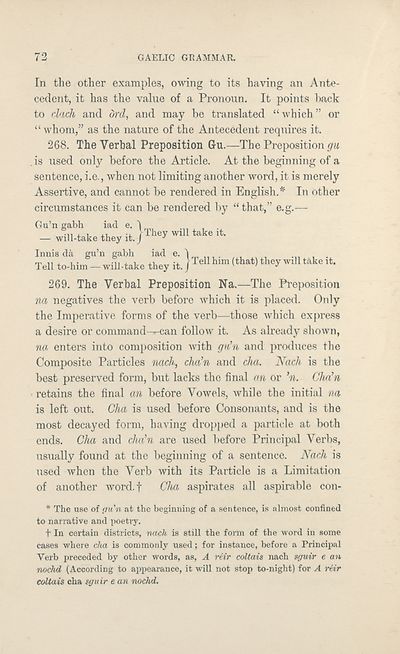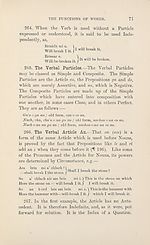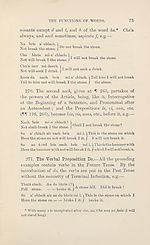Download files
Complete book:
Individual page:
Thumbnail gallery: Grid view | List view

GAELIC GRAMMAR.
In the other examples, owing to its having an Ante¬
cedent, it has the value of a Pronoun. It points back
to dach and ore?, and may be translated “which” or
“ whom,” as the nature of the Antecedent requires it.
268. The Verbal Preposition Gu.—The Preposition gu
. is used only before the Article. At the beginning of a
sentence, i.e., when not limiting another word, it is merely
Assertive, and cannot be rendered in English.* In other
circumstances it can be rendered by “ that,” e.g.—
Gu’n gabh iad e. i .
-will-take they it. }They wl11 ^
Innis da gu’n gabh iad e. 1
Tell to-him — will-take they it. ] Tell h,m (that) they wdlt&ke it.
269. The Verbal Preposition Na.—The Preposition
na negatives the verb before which it is placed. Only
the Imperative forms of the verb—those which express
a desire or command-r-can follow it. As already shown,
na enters into composition with gu’n and produces the
Composite Particles nach, cha’n and cha. JYach is the
best preserved form, but lacks the final an or ’n. Cha’n
retains the final an before Vowels, while the initial na
is left out. Cha is used before Consonants, and is the
most decayed form, having dropped a particle at both
ends. Cha and cha’n are used before Principal Verbs,
usually found at the beginning of a sentence. Nach is
used when the Verb with its Particle is a Limitation
of another word.f Cha aspirates all aspirable con-
* The use of gu'n at the beginning of a sentence, is almost confined
to narrative and poetry.
t In certain districts, nach is still the form of the word in some
cases where cha is commonly used; for instance, before a Principal
Verb preceded by other words, as, A reir coltcm nach sguvr e an
nochd (According to appearance, it will not stop to-night) for A riir
coltais cha sguir e an nochd.
In the other examples, owing to its having an Ante¬
cedent, it has the value of a Pronoun. It points back
to dach and ore?, and may be translated “which” or
“ whom,” as the nature of the Antecedent requires it.
268. The Verbal Preposition Gu.—The Preposition gu
. is used only before the Article. At the beginning of a
sentence, i.e., when not limiting another word, it is merely
Assertive, and cannot be rendered in English.* In other
circumstances it can be rendered by “ that,” e.g.—
Gu’n gabh iad e. i .
-will-take they it. }They wl11 ^
Innis da gu’n gabh iad e. 1
Tell to-him — will-take they it. ] Tell h,m (that) they wdlt&ke it.
269. The Verbal Preposition Na.—The Preposition
na negatives the verb before which it is placed. Only
the Imperative forms of the verb—those which express
a desire or command-r-can follow it. As already shown,
na enters into composition with gu’n and produces the
Composite Particles nach, cha’n and cha. JYach is the
best preserved form, but lacks the final an or ’n. Cha’n
retains the final an before Vowels, while the initial na
is left out. Cha is used before Consonants, and is the
most decayed form, having dropped a particle at both
ends. Cha and cha’n are used before Principal Verbs,
usually found at the beginning of a sentence. Nach is
used when the Verb with its Particle is a Limitation
of another word.f Cha aspirates all aspirable con-
* The use of gu'n at the beginning of a sentence, is almost confined
to narrative and poetry.
t In certain districts, nach is still the form of the word in some
cases where cha is commonly used; for instance, before a Principal
Verb preceded by other words, as, A reir coltcm nach sguvr e an
nochd (According to appearance, it will not stop to-night) for A riir
coltais cha sguir e an nochd.
Set display mode to:
![]() Universal Viewer |
Universal Viewer | ![]() Mirador |
Large image | Transcription
Mirador |
Large image | Transcription
| An Comunn Gàidhealach > An Comunn Gàidhealach Publications > Scottish Gaelic as a specific subject > (76) |
|---|
| Permanent URL | https://digital.nls.uk/125955929 |
|---|
| Description | This contains items published by An Comunn, which are not specifically Mòd-related. It includes journals, annual reports and corporate documents, policy statements, educational resources and published plays and literature. It is arranged alphabetically by title. |
|---|
| Description | A collection of over 400 items published by An Comunn Gàidhealach, the organisation which promotes Gaelic language and culture and organises the Royal National Mòd. Dating from 1891 up to the present day, the collection includes journals and newspapers, annual reports, educational materials, national Mòd programmes, published Mòd literature and music. |
|---|---|
| Additional NLS resources: |
|

